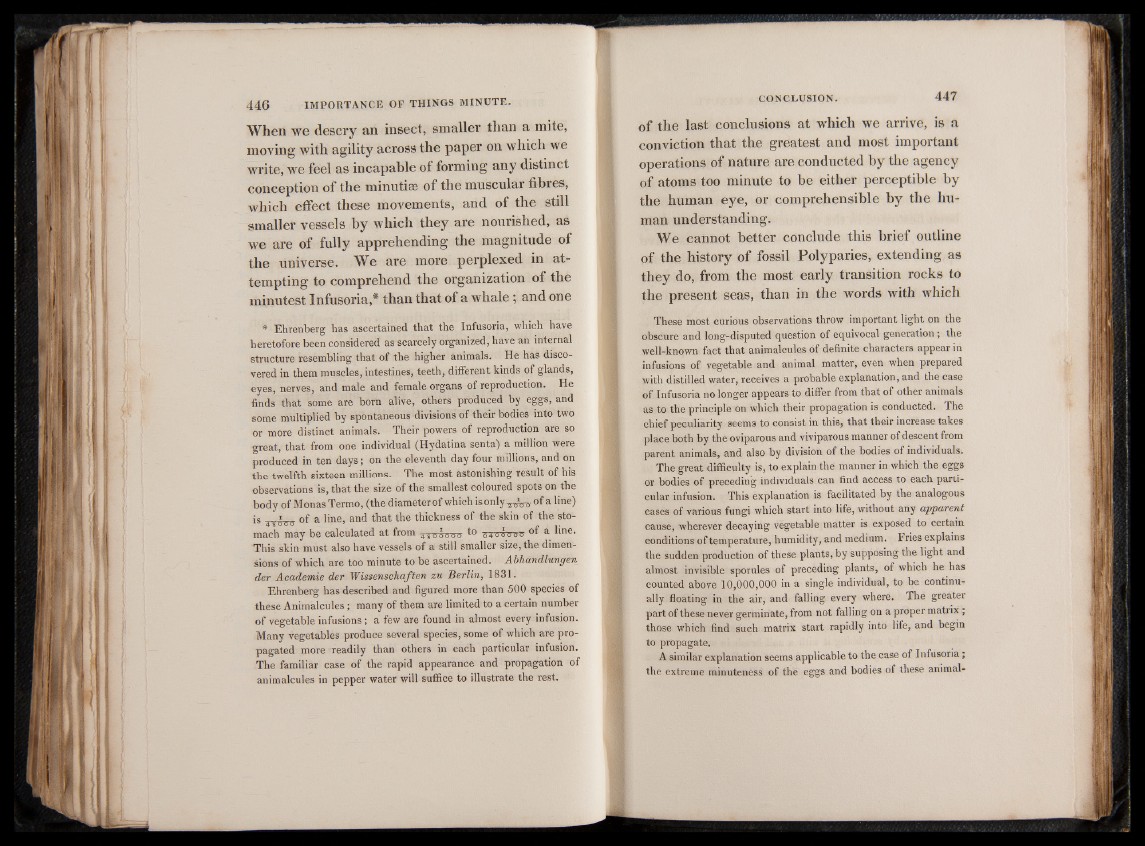
When we descry an insect, smaller than a mite,
moving with agility across the paper on which we
write, we feel as incapable of forming any distinct
conception of the minutise of the muscular fibres,
which effect these movements, and of the still
smaller vessels by which they are nourished, as
we are of fully apprehending the magnitude of
the universe. We are more perplexed in attempting
to comprehend the organization of the
minutest Infusoria,* than that of a whale; and one
* Ehrenberg has ascertained that the Infusoria, which have
heretofore been considered as scarcely organized, have an internal
structure resembling that of the higher animals. He has discovered
in them muscles, intestines, teeth, different kinds of glands,
eyes, nerves, and male and female organs of reproduction. He
finds that some are born alive, others produced by eggs, and
some multiplied by spontaneous divisions of their bodies into two
or more distinct animals. Their powers of reproduction are so
great, that from one individual (Hydatina senta) a million were
produced in ten days; on the eleventh day four millions, and on
the twelfth sixteen millions. The most astonishing result of his
observations is, that the size of the smallest coloured spots on the
body of Monas Termo, (the diameter of which is only of a line)
is of a line, and that the thickness of the skin of the stomach
may be calculated at from -A i alc>sa t° weraw'ow a ^ne>
This skin must also have vessels of a still smaller size, the dimensions
of which are too minute to be ascertained. Abhandlungen
der Academie der Wissenschaften zu Berlin, 1831.
Ehrenberg has described and figured more than 500 species of
these Animalcules; many of them are limited to a certain number
of vegetable infusions; a few are found in almost every infusion.
Many vegetables produce several species, some of which are propagated
more readily than others in each particular infusion.
The familiar case of the rapid appearance and propagation of
animalcules in pepper water will suffice to illustrate the rest.
of the last conclusions at which we arrive, is a
conviction that the greatest and most important
operations of nature are conducted by the agency
of atoms too minute to be either perceptible by
the human eye, or comprehensible by the human
understanding.
We cannot better conclude this brief outline
of the history of fossil Polyparies, extending as
they do, from the most early transition rocks to
the present seas, than in the words with which
These most curious observations throw important light on the
obscure and long-disputed question of equivocal generation; the
well-known fact that animalcules of definite characters appear in
infusions of vegetable and animal matter, even when prepared
with distilled water, receives a probable explanation, and the case
of Infusoria no longer appears to differ from that of other animals
as to the principle on which their propagation is conducted. The
chief peculiarity seems to consist in this, that their increase takes
place both by the oviparous and viviparous manner of descent from
parent animals, and also by division of the bodies of individuals.
The great difficulty is, to explain the manner in which the eggs
or bodies of preceding individuals can find access to each particular
infusion. This explanation is facilitated by the analogous
cases of various fungi which start into life, without any apparent
cause, wherever decaying vegetable matter is exposed to certain
conditions of temperature, humidity, and medium. Fries explains
the sudden production of these plants, by supposing the light and
almost invisible sporules of preceding plants, of which he has
counted above 10,000,000 in a single individual, to be continually
floating in the air, and falling every where. The greater
part of these never germinate, from not falling on a proper matrix;
those which find such matrix start rapidly into life, and begin
to propagate.
A similar explanation seems applicable to the case of Infusoria;
the extreme minuteness of the eggs and bodies of these animal